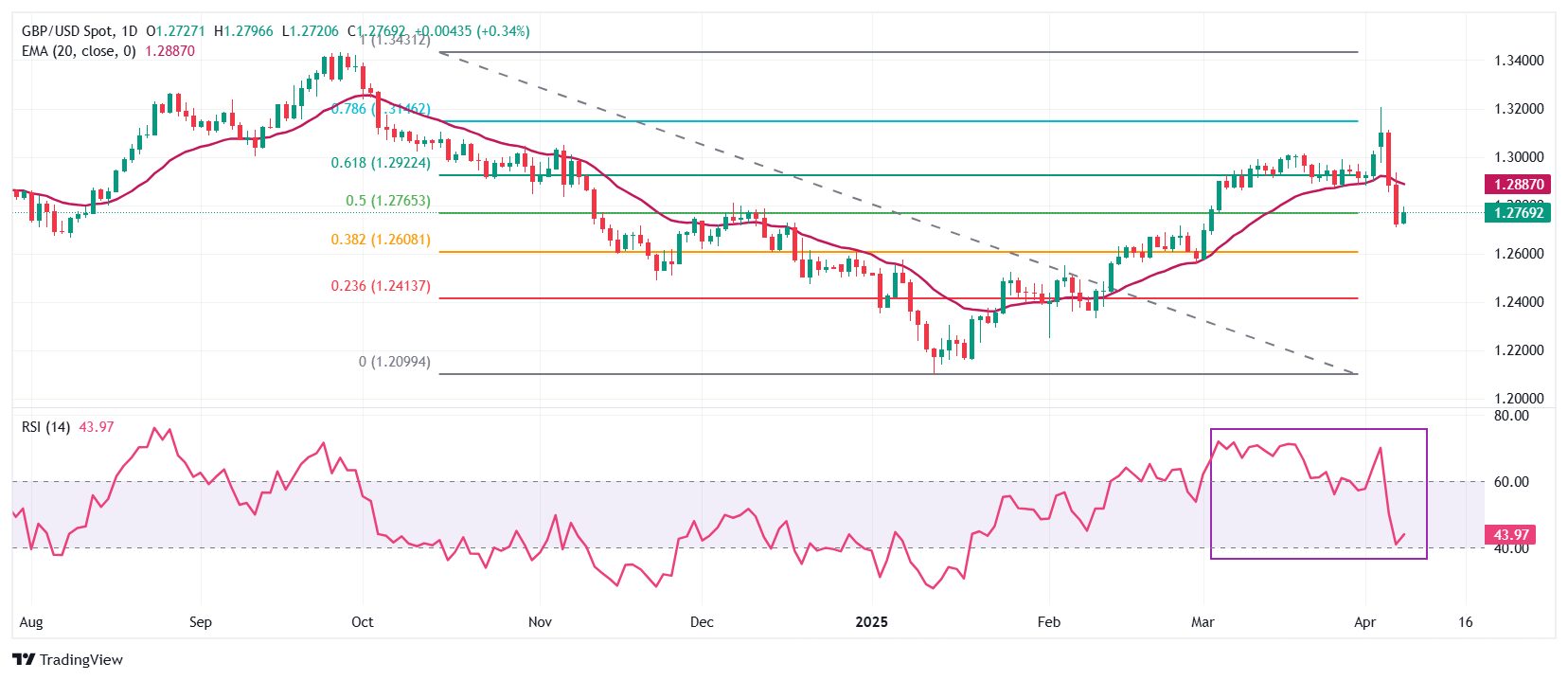- The Pound Sterling rebounds slightly against the US Dollar as traders have raised Fed dovish bets for the June meeting.
- The US-China trade war could lead the UK economy into a downturn.
- Fed Goolsbee stated that there is no generic answer to what the central bank should do to contain stagflation.
The Pound Sterling (GBP) underperforms its major peers on Tuesday as financial market participants expect Donald Trump’s tariffs-led fears of global economic slowdown could send the United Kingdom (UK) economy into a downturn.
Market experts believe the trade war will be majorly between the US and China as the latter has announced retaliatory measures despite Trump’s warning his trading partners not to retaliate after imposing reciprocal tariffs on April 2. Though the Eurozone is also planning countermeasures in the face of a new suite of tariffs by Donald Trump, the region is still expected to negotiate humbly.
A massive trade war between the US and China would result in the dumping of products by Chinese firms to other markets. Given the competitiveness of Chinese firms in manufacturing goods at cheaper rates compared to other nations, UK businesses would be incapable of competing against them in a pricing war. Such a scenario would lead to a sharp decline in UK business activity, which will be unfavorable for the Pound Sterling.
With UK Prime Minister Keir Starmer already sensing the pricing war has vowed to protect domestic firms from the storm of Trump tariffs. “We stand ready to use industrial policy to help shelter British business from the storm,” Starmer said over the weekend.
Escalating fears of UK economic risks could also force Bank of England (BoE) officials to adopt an aggressive monetary policy easing approach this year. The BoE has cut interest rates in one of two policy meetings in 2025 and is expected to deliver two more this year.
This week, the British currency will be influenced by the US Consumer Price Index (CPI) data for March and the monthly UK Gross Domestic Product (GDP) data for February, which will be released on Thursday and Friday, respectively.
British Pound PRICE Today
The table below shows the percentage change of British Pound (GBP) against listed major currencies today. British Pound was the strongest against the US Dollar.
| USD | EUR | GBP | JPY | CAD | AUD | NZD | CHF | |
|---|---|---|---|---|---|---|---|---|
| USD | -0.23% | -0.36% | -0.54% | -0.48% | -0.94% | -0.93% | -0.58% | |
| EUR | 0.23% | -0.17% | -0.32% | -0.26% | -0.71% | -0.66% | -0.35% | |
| GBP | 0.36% | 0.17% | -0.17% | -0.06% | -0.53% | -0.49% | -0.11% | |
| JPY | 0.54% | 0.32% | 0.17% | 0.03% | -0.41% | -0.45% | -0.02% | |
| CAD | 0.48% | 0.26% | 0.06% | -0.03% | -0.47% | -0.43% | -0.03% | |
| AUD | 0.94% | 0.71% | 0.53% | 0.41% | 0.47% | 0.05% | 0.42% | |
| NZD | 0.93% | 0.66% | 0.49% | 0.45% | 0.43% | -0.05% | 0.38% | |
| CHF | 0.58% | 0.35% | 0.11% | 0.02% | 0.03% | -0.42% | -0.38% |
The heat map shows percentage changes of major currencies against each other. The base currency is picked from the left column, while the quote currency is picked from the top row. For example, if you pick the British Pound from the left column and move along the horizontal line to the US Dollar, the percentage change displayed in the box will represent GBP (base)/USD (quote).
Daily digest market movers: Pound Sterling trades higher against USD as Fed dovish bets swell
- The Pound Sterling bounces back to near 1.2800 against the US Dollar (USD) in Tuesday’s European session from the monthly low of 1.2707 posted on Monday. The GBP/USD pair recovers as the US Dollar resumes its downside move after a short-lived recovery in last two trading days. The US Dollar Index (DXY), which tracks the Greenback’s value against six major currencies, tumbles to near 102.90.
- The Greenback remains on the backfoot as traders have become increasingly confident that the Federal Reserve (Fed) could reduce interest rates earlier this year to offset fears of potential United States (US) economic recession. According to the CME FedWatch tool, traders are almost certain that the central bank will resume its monetary policy easing cycle in the June policy meeting, which it paused in January.
- The imposition of reciprocal tariffs by US President Donald Trump and fears of countermeasures by China and the Eurozone have stemmed the risks of a recession in the US. Investment banking firm Goldman Sachs has raised the probability of the US entering a recession to 45% from 35%, as anticipated last week.
- The commentary from Fed officials has indicated that they are clueless about how protectionist policies by the President will shape the economic and the monetary policy outlook. Chicago Federal Reserve Bank President Austan Goolsbee said in an interview with CNN on Monday, “The anxiety is if these tariffs are as big as what are threatened on the US side, and if there’s massive retaliation, and then if there’s counter-retaliation again, it might send us back to the kind of conditions that we saw in 2021-22 when inflation was raging out of control,” Reuters report.
- Goolsbee added that our job is to look at the “hard data”, and if we have something that is called “stagflation,” then there is no “generic answer” to what the Fed should do “in response to that”.
Technical Analysis: Pound Sterling stays below 20-day EMA

The Pound Sterling looks to gain ground above 1.2700 against the US Dollar on Tuesday after facing intense selling pressure in the last two trading days. The GBP/USD pair trades below the 20-day Exponential Moving Average (EMA), which is around 1.2887, suggesting that the near-term trend is bearish.
The 14-day Relative Strength Index (RSI) falls to near 40.00. A fresh bearish momentum could be triggered if the RSI fails to hold the 40.00 level.
Looking down, the 38.2% Fibonacci retracement plotted from late September high to mid-January low, near 1.2600, will act as a key support zone for the pair. On the upside, the psychological figure of 1.3000 will act as a key resistance zone.
US-China Trade War FAQs
Generally speaking, a trade war is an economic conflict between two or more countries due to extreme protectionism on one end. It implies the creation of trade barriers, such as tariffs, which result in counter-barriers, escalating import costs, and hence the cost of living.
An economic conflict between the United States (US) and China began early in 2018, when President Donald Trump set trade barriers on China, claiming unfair commercial practices and intellectual property theft from the Asian giant. China took retaliatory action, imposing tariffs on multiple US goods, such as automobiles and soybeans. Tensions escalated until the two countries signed the US-China Phase One trade deal in January 2020. The agreement required structural reforms and other changes to China’s economic and trade regime and pretended to restore stability and trust between the two nations. However, the Coronavirus pandemic took the focus out of the conflict. Yet, it is worth mentioning that President Joe Biden, who took office after Trump, kept tariffs in place and even added some additional levies.
The return of Donald Trump to the White House as the 47th US President has sparked a fresh wave of tensions between the two countries. During the 2024 election campaign, Trump pledged to impose 60% tariffs on China once he returned to office, which he did on January 20, 2025. With Trump back, the US-China trade war is meant to resume where it was left, with tit-for-tat policies affecting the global economic landscape amid disruptions in global supply chains, resulting in a reduction in spending, particularly investment, and directly feeding into the Consumer Price Index inflation.

